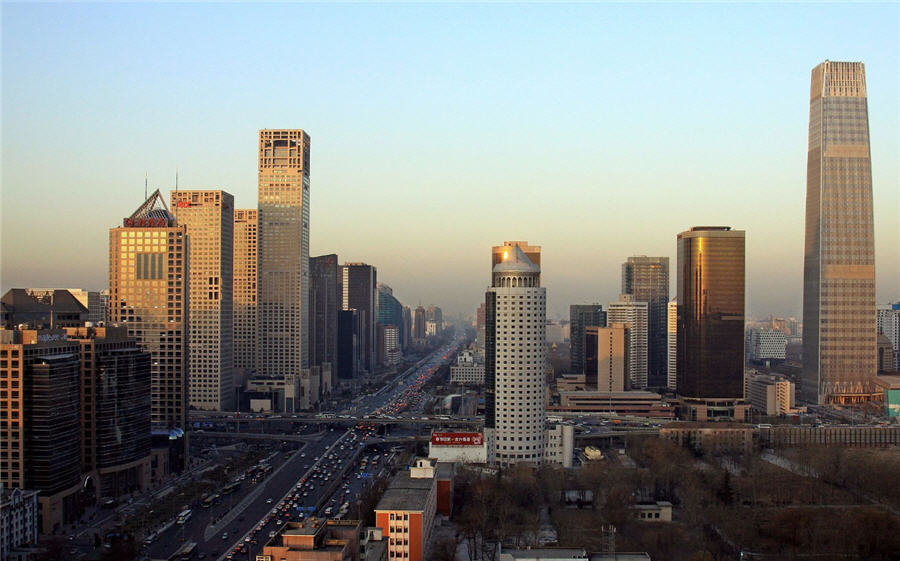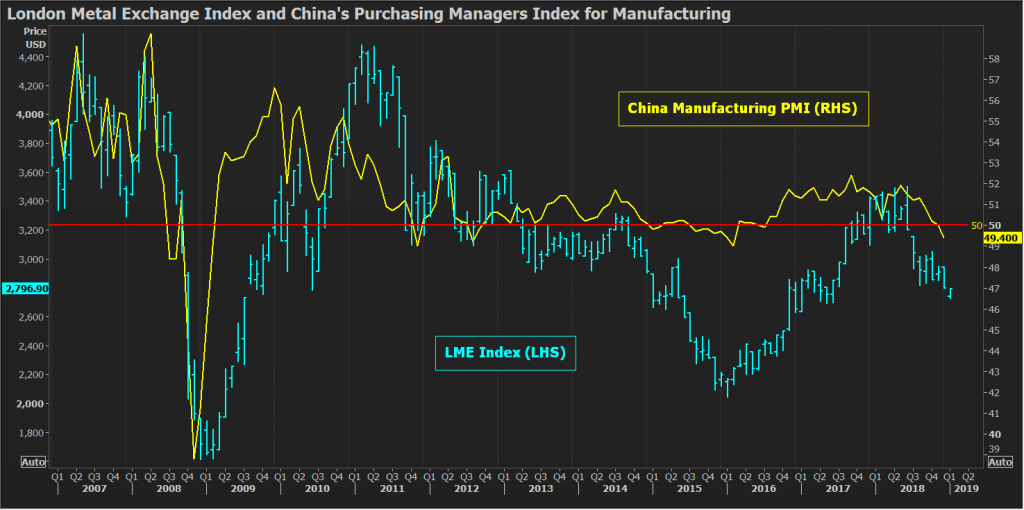
Base metals started the new year where they left off the old one, by falling again.
The London Metal Exchange index (LMEX) slumped to a one-and-a-half year low of 2730.1 on Jan. 3.
The trigger was Apple Inc’s revenue warning, not the type of news event that normally roils prices of old-economy metals such as copper, lead and zinc.
But the reaction was highly instructive of what to expect in the months ahead.
It signals that base metals continue to be beholden to the bigger financial narrative, locked into a risk-on, risk-off dance with global markets, particularly the U.S. stock market.
First and foremost, it signals that base metals continue to be beholden to the bigger financial narrative, locked into a risk-on, risk-off dance with global markets, particularly the U.S. stock market.
The linkage comes in the form of U.S. President Donald Trump and the tariffs tension with China.
What really spooked global markets in Apple’s rare warning was the company’s comments about disappointing sales in China, an ominous sign that a slowdown in the world’s second largest economy risks ricocheting on the world’s largest.
Such fears were only exacerbated by sliding manufacturing purchasing managers’ indices in both countries.
Signs of actual contraction in China bode particularly ill for metals, given the country remains the engine of growth in global usage.
Metals bulls are banking on Beijing doing what it always does when the going gets tough, opening the taps and stimulating investment down the usual infrastructure and construction channels.
We’ve been here before in 2009 and 2015 and both times the trick worked. This time, however, could be different.

Both China’s official manufacturing PMI and the Caixin PMI, which captures the mood among the country’s smaller companies, fell below the 50 level in December, signalling slowdown has become outright contraction.
The last time this happened was in 2015, a year of misery for the LME metals complex, which only bottomed out in January 2016.
There was no trade war back then but the core driver is the same. Both slowdowns were made in China by the Chinese government.
Beijing’s target last year was the same as in 2015, namely to soak up excess liquidity caused by the previous stimulus and its most obvious manifestation in disorderly property markets.
Metals analysts have been fretting about the impact of China’s credit tightening for many months, particularly since it has hit hardest the relatively dynamic private sector.
This time around, they have more to worry about.
Overlaying the credit chill effect on manufacturing activity has been Beijing’s new “war on smog” policy.
Analysts tend to focus on the winter heating season restrictions but the environmental crackdown has been running continuously for over a year and has encompassed every part of China’s metals economy.
Many smaller companies, both producers and users, have been closed while even official-sector supply chains have been upended by rounds of inspections and restrictions.
It’s impossible to quantify the cumulative hit in terms of headline growth but there is no doubt that the clean air campaign has been a significant drag and one that isn’t going to go away any time soon.
The two government policies have combined to hit China’s manufacturing sector even before the tariffs effect comes fully into play.
The Chinese authorities have reacted with an increased sense of urgency to the deteriorating economic picture.
More infrastructure spending has been promised with the focus on urban subway systems, high-speed railways and power grid spending.
This week has brought a bigger stimulus jab in the form of a cut in banks’ reserve ratios, in effect freeing up $116 billion in new lending.
However, Beijing’s stimulus cycle is subject to the law of diminishing returns. The scale of stimulus in 2015-2016 was much smaller than that of 2009 and the third is likely to be smaller still.
Not only is it physically impossible to replicate the amount of infrastructure built over the last 10 years – there are, after all, only so many airports and high-speed railway lines that even China needs.
But Beijing is now wary, third time around, of the excess that inevitably follows a government-made boom.
Look, for example, at the residential property sector, where policymakers are still warning of speculative excess and trying to wean regional governments off their financial addiction to land sales.
Stimulus the third time around will be no shock-and-awe package but, rather, an attempt to smooth out select areas of weakness in the Chinese economy.
It will also take time to flow through to tangible metals demand.
A broad analyst consensus is that the impact of the current round of Chinese stimulus will start to lift metals prices some time in the second quarter.
Before then, to quote Goldman Sachs, “industrial metals are likely to face material headwinds and remain volatile in (the first quarter).” That Jan. 4 prognosis accompanied a downgrade of the bank’s near-term price forecasts.
Goldman, however, like many commentators is still constructive on the medium-term outlook, maintaining 12-month targets of $7,000 per tonne for copper and $2,000 for aluminium, compared with current prices of $5,930 and $1,860 respectively.
The next few months, everyone seems to agree, are going to be difficult ones for bulls.
There is plenty of potential for sharp corrective rallies. Speculators are short metals across the LME board, according to broker Marex Spectron.
In cases such as aluminium and nickel the positioning is extreme, which is why both are eating into production cost curves.
A corrective bounce is only a presidential tweet away as the markets try and read the smoke signals from the ongoing trade talks between the United States and China.
But any rally may be of the dead cat variety.
Hopes for a trade war peace, or at least a truce, may dominate short-term sentiment but tariffs on China will only accelerate or brake a process that is already underway.
China engineered its current slowdown and now it must engineer growth.
Beijing’s biggest problem is how to do this without repeating the mistakes of the past and simply generating a new round of the stimulus-boom-bust cycle that played out after 2009 and 2015.
Complicating this balancing act is the “blue skies” promise made by President Xi Jinping to the Chinese people. The clean air campaign can be dialled down but it cannot be reversed.
And lastly, but not least, Beijing must try and reinvigorate its economy just as manufacturing growth everywhere else is starting to slow.
It’s a tall order.
China’s third stimulus in a decade may not prove to be three times lucky for industrial metals.
(The opinions expressed here are those of the author, a columnist for Reuters.)
(By Andy Home, editing by Susan Fenton)